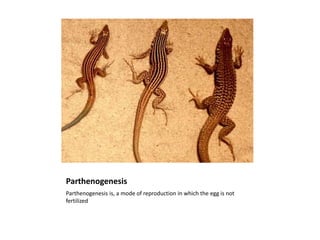
Parthenogenesis: Virgin Birth in Animals
- 1. Parthenogenesis Parthenogenesis is, a mode of reproduction in which the egg is not fertilized
- 4. In 2002, Shark gives virgin birth in Detroit A virgin birth?: She hadn't been near a male for six years. There are possibilities other than parthenogenesis: Sperm storing? Hermaphrodite?
- 5. Kaguya Parthenogenesis does not occur naturally in mammals, but in April 2004, Japanese scientists announced they created the first mammal by combining the nucleus of one female’s egg with that of another. The female offspring survived to adulthood and now has babies of her own.
Notas del editor
- Parthenogenesis is, a mode of reproduction in which the egg is not fertilized. These so-called virgin births are common in invertebrates like snails, but are unusual in higher vertebrates. Parthenogenesis has been documented in many reptiles. There are at least five or six species of snakes, and it's been known in salamanders, lizards, and even a breed of turkeys.
- Rethinking Shark Reproduction A female white spotted bamboo shark at the Belle Isle Aquarium in Detroit surprised zookeepers in July by giving birth to two babies. Why the surprise? It was a virgin birth: She hadn't been near a male for six years. The births have raised questions among scientists as to whether sharks may be able to reproduce parthenogenetically, a mode of reproduction in which the egg is not fertilized. There are possibilities other than parthenogenesis: The Belle Isle white spotted bamboo shark may have been fertilized by a male at a very young age. However, although there have been some random reports of shark species storing sperm for a couple of months or more, six years is a long time, and in this case it's extremely unlikely. Another possibility is that the Belle Isle bamboo shark is a hermaphrodite, harboring both male and female sex organs, and capable of fertilizing its own eggs. Fish are known to have the only self-fertilizing hermaphrodite vertebrate species, but in the case of sharks it appears to be unlikely.
- Parthenogenesis (reproduction without fertilization), occurs naturally in some plant and insect species. Parthenogenesis does not occur naturally in mammals, but in April 2004, Japanese scientists announced they created the first mammal by combining the nucleus of one female’s egg with that of another. The female offspring survived to adulthood and now has babies of her own. They call her Kaguya, after a Japanese fairy tale. Kaguya has challenged the concept that paternal imprinting prevents parthenogenesis, ensuring that the paternal contribution is obligatory for the descendant.